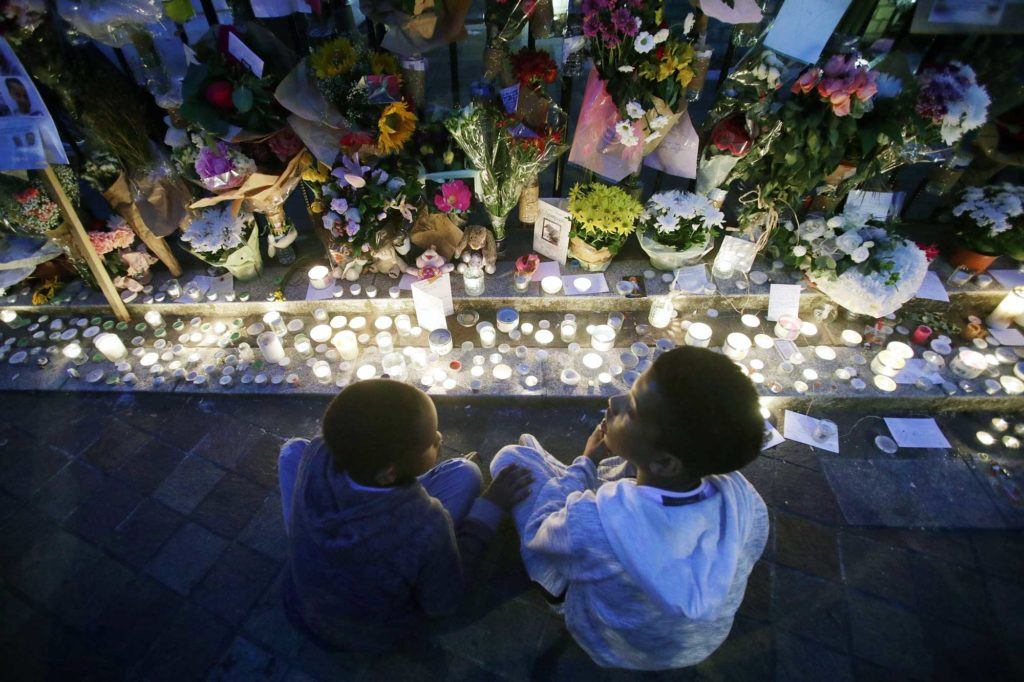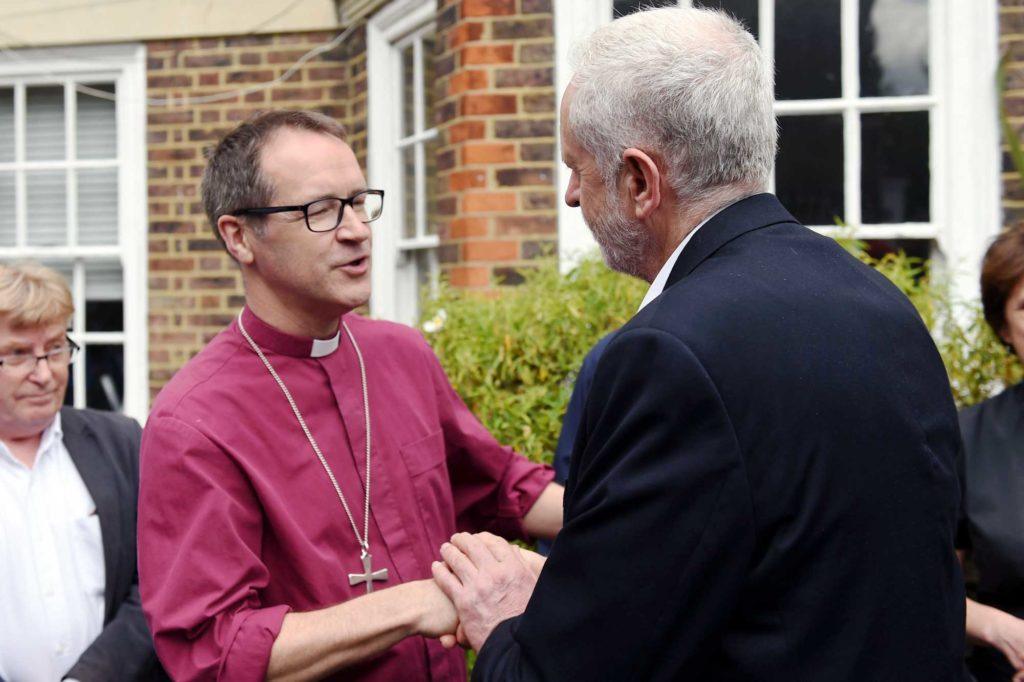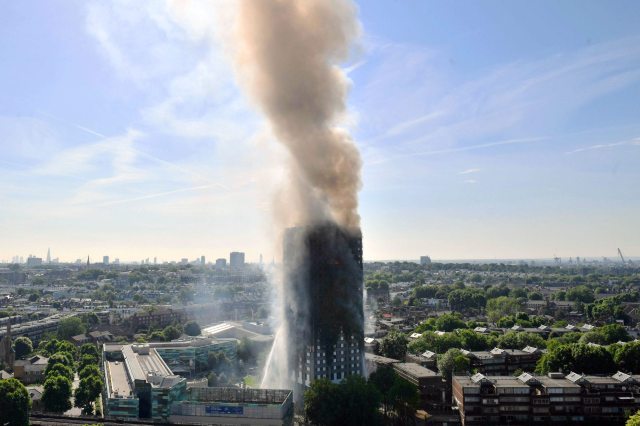Victoria Jones/PA Wire/PA Images

The Grenfell Tower fire disaster is teaching Britain many lessons. Some of them will have to await the findings of inquiries and inquests. But already it is clear that the sclerotic bureaucracies of local and national government were not up to the job. Inadequate building materials and firefighting equipment may have deepened the tragedy. The confusing contradictions in the flow of official information are continuing to cause anger and frustration on the streets where the atmosphere remains suspicious and on edge.
There is, however, one group of emergency service workers who have won unexpected plaudits. They are the volunteers from faith groups who spontaneously provided both pastoral and practical services to the local community. Cooperating with each other from churches, mosques, temples, synagogues and charity offices, they responded with immediate effectiveness both outwards to local residents and upwards to decision makers. This extraordinary community effort has been a story of hope, faith and action which deserves further attention.

Perhaps the most important lesson to emerge from the disaster is that these locally trusted groups, working together as never before, have filled huge gaps which mistrusted official organisations could not reach. Faith leaders have also been helping to build bridges and to encourage a mood of calm after the firestorm. This healing will be needed for many months to come.
Chronologically, on the night of Wednesday June 14, the first faith workers in action on the scene were The Salvation Army whose emergency response unit arrived at the foot of the tower an hour or so after the fire started. Their red vans, each staffed by four uniformed officers, dispensed tea, sandwiches, chocolate bars and comfort on such a scale that two more of these vehicles were summoned as reinforcements.
The “Sally Ally” has been providing this type of emergency service ever since the Boer War. It has a professional link, established during ‘The Blitz’, with the Fire Service whose 21st century computers now automatically alert Salvation Army Headquarters whenever six or more appliances are heading for a big conflagration, disaster, or terrorist episode. The emergency units which are on permanent standby in all Britain’s leading cities, are backed up by corps volunteers who “loiter with intent”, as their commander puts it, to offer a sympathetic shoulder, a listening ear or a word of prayer to traumatised victims.
Localism was important in making the contribution of faith groups effective. Churches have networks on the ground, so even in the middle of the night the local pastors and parishioners knew exactly who to call and where to go. The first vicar to jump out of his bed on hearing the sirens and smelling the smoke was the Revd Sean Doherty who lives on the Waynflete Square Social Housing Estate, 300 yards from the Tower. Pulling on his dog collar, he knocked on the door of Father Alan Everett, whose Anglican church, St Clement’s, is even closer. Together they opened up the doors, brewed up the tea urn and welcomed in a steady flow of residents fleeing from the flames. By 3.30am about 200 displaced persons had arrived in St Clement’s, many agonising about the fate of friends and family members.
In those first few hours when police officers drafted in from East and Outer London were, without local knowledge, directing people to mustering points which did not exist, the community turned to St Clement’s as its first port of call.
The local Al-Manaar Mosque received massive relief supplies from the West London Synagogue – a unique partnership between Jews and Muslims created two weeks before the fire
Meanwhile a mile or so away in Acklam Road, the largest mosque in the area, Al-Manaar had just finished the Ramadan night prayer of Ishah. Over 2,000 local Muslims had been sharing in the breaking of the fast meal of Iftar. Most of them drifted away after the prayers without realising that a fire had started in the Tower. But once the magnitude of the drama was recognised, Al-Manaar’s Chief Executive Abdurahman Sayed declared “Keep our doors open for anyone – Muslim or non-Muslim”. So the mosque also became a major relief centre.
As morning was breaking, supplies came pouring in. The Al-Manaar mosque received a huge delivery of food, water, blankets and toiletries from the West London Synagogue.
Synagogue? Hasn’t the mainstream media been reporting for years on the enmity between Jews and Muslims? Fake or at least out of date news. Two weeks before the fire the Rabbis and leaders of the West London Synagogue at Marble Arch invited their opposite numbers from the Al-Manaar mosque to join them in a combined celebration of a Ramadan fast-breaking meal. Contacts and friendships were established. So on the night of the fire, Jewish generosity responded magnificently to Muslim need.
What seemed special soon became typical. The charity Muslim Aid sent large consignments of relief supplies that night to St Clement’s Church and later to the Methodist and Catholic churches near the Tower. By contrast the local authority seemed paralysed. One hapless RBKC bureaucrat said, in a call to St Clement’s when it was bursting at the seams with survivors, “But you are not a designated relief centre!”
Another faith group swinging into action were the Sikhs from their Gurdwara or temple at Holland Park. An important Sikh tradition is serving a Langar or daily hot meal to the poor. So a relay team of Sikhs set up a street kitchen to provide free rice, lentil stew and bottled water outside Latimer Road Christian Centre. “We cooked it, but a stream of Christian, Muslim, Hindu and other volunteers served it” said Gurpreet Singh, Youth Secretary of the Central Gurdwara, “providing food in this friendly way created a sense of community during the time when the tensions were rising so sharply that we feared we might be on a brink of a riot”.
What was needed in those chaotic first days was not just good works but good leadership. It could not be provided by Kensington and Chelsea Councillors or officials who were getting booed and jostled in a worsening atmosphere of animosity.

The Bishop of Kensington, Graham Tomlin (pictured above) played key leadership role
Fortunately, one of the first arrivals at the Tower was Graham Tomlin, Bishop of Kensington. Alerted early by a text from the Chaplain to the Metropolitan Police, Jonathan Osborne, Bishop Graham was allowed within the inner cordon.
He spent most of the morning at the foot of the still burning tower ministering to shattered victims and exhausted firefighters “I just went up to them asking how are you, how are you coping, what’s it been like in there?” recalled Graham Tomlin “naturally some of them were quite emotional. Voicing their experiences, often pretty awful experiences, seemed to be more helpful than bottling it up inside themselves. In or two cases it was appropriate to pray with them. One firefighter who invited me to do that saw me the next day and said ‘you don’t know how significant that prayer was. It came just when I needed it’”.
Bishop Graham, in his purple episcopal shirt and pastoral cross, was an easily identifiable figure. Realising that spiritual visibility could be useful, he emailed the clergy in his diocese suggesting that they too might come to North Kensington as listeners and helpers. Within hours “you could hardly move for vicars” reported Danny Kruger, a former David Cameron speech writer turned charity worker, who lives on a council estate close to Grenfell Tower.
Dog collars have been known to attract ridicule but now they were welcomed as trusted symbols of care and compassion. “Father, can I talk to you” was a much repeated opening. So helpers from many denominations helped out on a myriad of tasks from spiritual comforting to physical heavy lifting. This was essential to shift the avalanche of relief supplies that kept pouring into St Clement’s, Al-Manaar and several other centres. One estimate suggested that over two football pitches would have been filled by gifts for the victims.
There were not many lighter moments in this mammoth operation, but one came when a group of Muslim helpers delivered several cases of dog food to St Clement’s Church. Dog food? The receiving vicar on duty, Father James Heard murmured some quiet Anglican doubts. O He of little faith! Within minutes some evacuated residents from nearby flats close to the tower came in to ask where they might find dog food for their pets.
Unlike some of the key figures in leadership roles around Grenfell Tower, Graham Tomlin was restrained in his criticism of local and central government. He understood that bridges had to be built between distraught individuals and the authorities who hold the funds and the legal powers. The established church still knows its way around the establishment. So connecting up with a helpful aide at No 10, it was Bishop Graham who chaired Theresa May’s second visit to the site on Friday June 16 when for the first time she met local residents.
That meeting ended after only 45 minutes because of security warnings about the mood of the crowd gathering outside St Clement’s. But the following day Bishop Graham was invited to lead a diverse delegation from the local community to No 10. The Prime Minister listened for over two hours and acted in response to the many complaints about the lack of co-ordination, the need for one central base for relief work, the shortage of ready cash to help dislocated families, and the mistrust about conflicting information about official sources. On all these fronts real movement started.
Nevertheless, one month on from the outbreak of the fire, feelings on the ground remain raw. As Danny Kruger puts it:
“We are not at peace but in a truce which may not last”.
Last weekend visiting the Al-Manaar mosque, I met a victim of the disaster who personified both the present fragility and the potential strength of the truce. He was Hassan Awad, originally from Khartoum. Travelling abroad on the night of the fire, his home was Apartment 203 on the 23rd floor of Grenfell Tower where he lived with his wife Rasha Ibrahim (they were married in the mosque) and their two daughters Fethia 5 and Hania 3. All three perished in the flames. Their bodies have not yet been recovered.
“I know my wife and children have gone to God” says Hassan, “but every day I get a different story about their remains. Last week I was told by the Coroner’s Office that nothing could ever be recovered from my flat. But yesterday a police officer called me to say that six pieces of human body parts have been found there; Yet it may be weeks before they can be taken out for burial. Why oh why does it take so long?”
Such personal anguish, expressed with inspirational calm and dignity by Hassan Awad, is accompanied in many other distressing cases by understandable anger. This mood will not be assuaged in council offices, even though the new RBKC Leader Elizabeth Campbell has made appropriate statements in the right tone in recent days.
So there is a continuing role to be played by faith groups. They are now rising to the challenge of providing below the radar support to those affected by the disaster. The bonds of loving unity forged by the flames will endure. The visible will be replaced by the invisible. Places of worship of all faiths have already become safe spaces for counselling and comforting. They may also be sources of trusted advice particularly when it comes to holding the authorities to account for the reforms that are being promised.
There are no quick fixes for this scarred community, certainly not if they come too glibly from politicians or the mainstream media.
Yet out of this terrible tragedy there are reasons for hoping that long term good will come. Indeed it is already a reality that the foundations laid by faith groups over many years of quiet service and witness to the community now feel like the surest starting points from which to build the truce into a peace.









Join the discussion
Join like minded readers that support our journalism by becoming a paid subscriber
To join the discussion in the comments, become a paid subscriber.
Join like minded readers that support our journalism, read unlimited articles and enjoy other subscriber-only benefits.
Subscribe